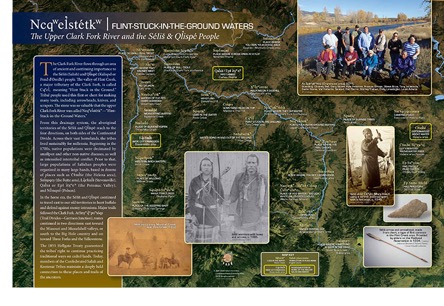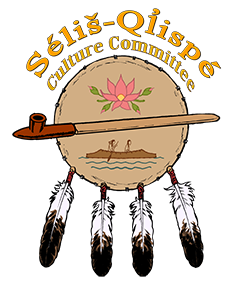Uncategorised
2023 Selis u Qlispe - Nations Names & Territories
Séliš-Ql̓ispé TIMELINE | since the last ice age
St̓lt̓úlix͏ʷs Séliš u Ql̓ispéSt̓lt̓úlix͏ʷs Séliš u Ql̓ispéTerritories of the Salish, Kalispel & Related Nations
Nɫʔay | PLACE OF SMALL BULL TROUT The Missoula Area and the Séliš & Ql̓ispé People
Séliš-Ql̓ispé Ethnogeographic Signs Initiative (SQESI)

Because many of the signs cover a large area, such as an entire drainage system, some signs are up in more than one location. As more signs go up in coming months and years, we will add them to this webpage.
We encourage you to visit each of the signs and reconnect with the places and place-names of the Séliš and Ql̓ispé people.
Click on the pin for directions to the sign.
Meaning of the Months
January
The Hand Shaking Month
Long ago, before the coming of the Black Robes and the trappers, our people, the Pend d' Oreille and Salish, would gather together for the mid-winter ceremonies. In these gatherings, they would sing what is called a hand shaking song.
The second name for January came about through the influences of the trappers and traders. During this time the people would gather together and shoot off their rifles and guns at midnight to welcome the New Year. After they shot off their rifles and guns, they would go back inside and sing the hand shaking song. After the song was sung, the people would have a small meal and head off to bed.
On New Year's Day, people gather at different homes for a day of feasts and fun. After the meal, we would drum and sing and dance. Then we have the Jump Dance. After this is all over, someone would stand up say where we’ll all be gathering for the next day, (at somebody else's home) to continue the Jump Dance. The Jump Dance continues for four days usually. Today, we have the Jump Dance here at the Long House. It is a time of giving thanks in prayers and thought. It is a time of renewal for the people and their families for the coming year.
February
Coldest Month
This is the month that our people regarded as the coldest month of the year. They called it ¢Äosqn because it meant it was very very cold. The weather was often below zero during this month and the snow deep. This month was a long hard time for the Indian people.
March
The Month of the Geese
When the geese were spotted flying in from the south,that was a good sign that the winter months were coming to an end. It was time to look ahead to warmer weather. During the first part of the month, some of the people would go to certain lakes to snag and trap fish. The people would be preparing for their hunting trips, berry picking, and root digging. This is also when the blackbirds would be arriving.
April
Month of the Buttercup
This is the Spring month. The first thunder is heard this month. All the bears, snakes, gophers, and other hibernating animals come out. Coyote stories are no longer told, they have been put away until the next snow fall. This is also the month when the S§iya¶mn(buttercup), yellow bells and little dog, pussy willows are in bloom. The Salish-Pend d'Oreille people used the S§iya¶mn as a medicine. The yellow bell was used as a fruit. It would be mixed with bitterroot.
May
Month of Bitterroot
About in May, each year the Salish & Pend d’Oreille people start digging S¿eém (bitterroot). When it was time to dig S¿eém, the Chief would select a group of women to go ahead and check the roots to see if it was ready. If it peeled easily, then it was ready. Following the feast, everyone is then free to dig all that they need. A long time ago the people, they'd all get together when it was time to dig bitterroot or camas and go together and camp for days where the bitterroot was plenty-full . They were making and storing food for the winter. Now days most of us are rich in food. We don't have such a hard time during the winter for our food anymore. But a long time ago the Indians had to make and store food all summer for the winter months as we had no money to be buying food each day or week like now.
June
Month Of Camas
This is usually the month when the Camas is ready to dig. The Camas is baked in the ground for three days with black tree moss. During this month the Salish People make bark baskets for berry picking. The bark is taken from Lodge pole and Cedar trees. We are always careful not to take too much off one tree so it won’t kill the tree. Tipi poles are cut during this month as well, they peel easier. When the wild-rose blossoms our people know that the buffalo are nice and fat. When the strawberries were ripe, the baby elk and deer were born.
July
Celebration Month
This is the middle of the summer months when all the people get together to celebrate and give thanks that they survived the wars and the long hard winter. The people donate in many ways to celebrate at this time of year. Each day several Indian leaders would gather at the Chiefs tipi to discuss the activities for that day. After they had it all planned, the camp crier would ride among the encampment to announce each activity. The annual Arlee Celebration is usually the first weekend of this month.
August
Month of the Huckleberry
The huckleberries ripen in the month of August and some as early as late July. The SÉÇÛ grew in abundance years ago. If they are plentiful, we would pick enough to last all winter and spring.
Our people use cedar bark baskets made earlier in the year for holding the berries. The baskets are light-weight and easy to carry. Berries never get crushed in these baskets. Other berries that are also ripe at this time are foam berries (Indian Ice Cream Berries), thimbleberries, and raspberries. As we still do today, through out the entire month of August we are picking and gathering the berries.
September
Month of the Chokecherry
The chokecherry is a dark red or black berry grown on tall bushes. It is one of the foods the Salish - Pend d' Oreille people picked for their winter supply.
This is also the month for wild grapes. After it is picked it may be eaten fresh or mashed for drying. Elderberries were also picked during this month. September is usually the month our people gathered the last of the berries for the winter supplies.
October
Hunting Month
A hunting party of young men would go up into hunting grounds. A leader would appoint two scouts to make a corral. The leader would give the directions and calls to let them know when to be ready and when to make moves. This way they would not waste any ammunition and you will have enough for another hunt. The animals were chased into the corral and only what was needed was taken. After the men killed enough meat for the camp they would then take all the meat back to camp. The women would slice and dry the meat and divide it equally among all the camps. They would pack their meat in their hunting packs and start for home.
November
Story Telling
Story telling begins after the first snowfall. This is a time of year when the Salish people relax from the Summer and early Fall harvesting seasons. Stories are told by parents and grandparents to the younger generations. The children are encouraged to sit quietly and listen with thoughts of their own about being part of the stories. The stories teach and tell of values and morals. From these stories we can still today see landmarks that tell us of the creation of mankind. From these stories, we learn how mankind came to be. In early spring the stories are put away and are not to be told until snowfall again in the winter season.
December
Trapping Month
This is the time of the year when Salish and Pend d' Oreille did the trapping. Some time ago, we trapped martin, weasel, mink, otter, beaver and muskrat. We use the skins of these animals in different ways - braid wraps, trimming for outfits among other uses. Today, these animals aren’t in as much as abundance as they once were long ago and are trapped and used carefully.
Copyright Notice
1.1 Copyright (c) 2015 Salish Pend d’Oreille Culture Committee.
1.2 Subject to the express provisions of this notice:
- we, together with our licensors, own and control all the copyright and other intellectual property rights in our website and the material on our website; and
- all the copyright and other intellectual property rights in our website and the material on our website are reserved.
- if you would like a copy of an audio, photo, video or document from our archives you may contact the culture committee and a review of your request will be conducted.
Copyright License
2.1 You may:
- view pages from our website in a web browser;
- download pages from our website for caching in a web browser;
- print pages from our website;
- stream audio and video files from our website; and
- use our website services by means of a tool and informational purposes subject to the other provisions of this notice.
2.2 Except as expressly permitted by the other provisions of this notice, you must not download any material from our website or save any such material to your computer.
2.3 You may only use our website for your own personal and business purposes, and you must not use our website for any other purposes.
2.4 Except as expressly permitted by this notice, you must not edit or otherwise modify any material on our website.
2.5 Unless you own or control the relevant rights in the material, you must not:
- republish material from our website (including republication on another website);
- sell, rent or sub-license material from our website;
- show any material from our website in public;
- exploit material from our website for a commercial purpose; or
- redistribute material from our website, save to the extent expressly permitted by this notice.
Acceptable Use
3.1 You must not:
- use our website in any way or take any action that causes, or may cause, damage to the website or impairment of the performance, availability or accessibility of the website;
- use our website in any way that is unlawful, illegal, fraudulent or harmful, or in connection with any unlawful, illegal, fraudulent or harmful purpose or activity;
- use our website to copy, store, host, transmit, send, use, publish or distribute any material which consists of (or is linked to) any spyware, computer virus, Trojan horse, worm, keystroke logger, rootkit or other malicious computer software; or
- conduct any systematic or automated data collection activities (including without limitation scraping, data mining, data extraction and data harvesting) on or in relation to our website without our express written consent.
Enforcement of Copyright
4.1 We take the protection of our copyright very seriously.
4.2 If we discover that you have used our copyright materials in contravention of the license set out in this notice, we may bring legal proceedings against you, seeking monetary damages and/or an injunction to stop you using those materials. You could also be ordered to pay legal costs.
Permissions
5.1 You may request permission to use the copyright materials on our website by downloading an Audio or Photo Request form.
